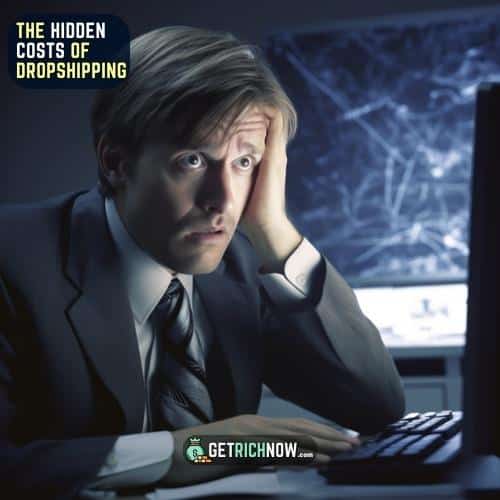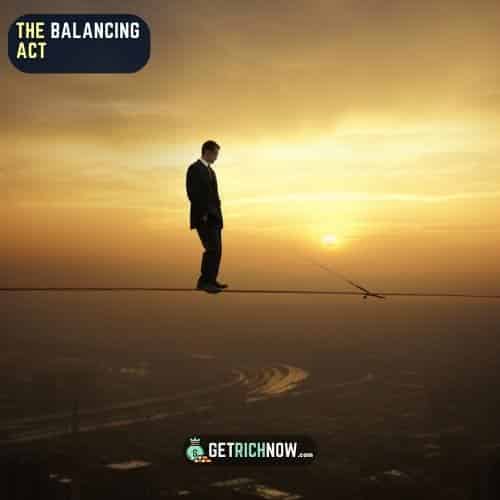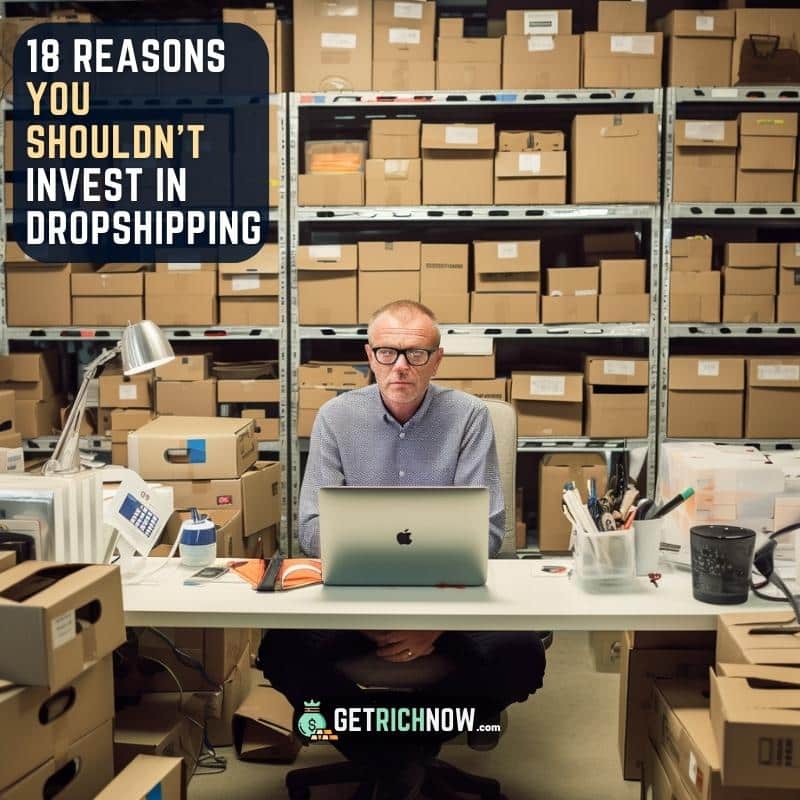Listen up, folks! If you seriously consider jumping onto the dropshipping bandwagon in 2023, hold your horses. Yes, we all love making quick bucks while sitting in our cozy homes, sipping coffee, and binge-watching our favorite shows. But before you get all starry-eyed, let's take a humorous yet insightful look at 18 reasons why you shouldn't invest in dropshipping in 2023.
1. The Dropshipping Market is as Crowded as a Black Friday Sale
Remember those scenes of people rushing into stores on Black Friday to get the best deals? Well, that's kind of how the dropshipping market works. Everyone and their grandmother want a piece of the pie, making it crowded. And don't forget that a big crowd means a lot of competition. You might have to push your way past a lot of competitors to get to your target customers.
2. Profit Margins are Thinner than a Sheet of Paper
We've all heard stories about how dropshipping can make you rich overnight. Well, I'm sorry to burst your bubble. In dropshipping, the profit margins are often so thin that a sheet of paper could beat them. And no, I'm not exaggerating. Suppliers and marketplaces may take a big chunk of what you get, leaving you with a small amount.
Examples of Hidden Fees in Dropshipping:
- Per Order Fees: This is the most common fee in dropshipping. Every time a sale is made, the dropshipper pays a fee to the supplier. This fee typically ranges from $2 to $15, depending on the type of products sold and the suppliers' services. Some suppliers might refer to this as a commission and charge a percentage of each sale instead of a fixed rate.
- Account Setup Fees: Dropshipping suppliers often charge a one-time fee to establish a relationship with the dropshipper. This fee, typically between $15 and $50, provides access to the wholesale price of the supplier's products and any product data.
- Membership Fees: This is a relatively new fee in the dropshipping model, charged either monthly or annually. The vendor determines the cost of this fee, but on average, it can be around $20 per month. This fee is usually required to access the vendor's entire product catalog or to pay discounted prices for specific products. This fee adds recurring payments to the vendors' revenue stream.
- Commission Rates: The typical commission rate in dropshipping ranges between 15% and 20%. This rate is the percentage of revenue from each sale paid to vendors, sales teams, or other parties responsible for driving sales. Dropshipping commissions are most commonly paid to product vendors and influencers who help advertise the products.
3. Control is Just a Fantasy
Control is as accurate as unicorns and leprechauns when it comes to dropshipping. Your suppliers decide what you can do. Who will get in trouble if they mess up an order? Yep, you. If they decide to raise their prices, you must change yours immediately. If they don't have enough, your business will stop. Control? It's more like chaos under control.
4. Delivery Times that Rival Snail Mail

With Amazon Prime and two-day shipping, dropshipping delivery times can seem like something from the past. We're talking weeks, not days. Your customers might get an extra year of age while they wait for their orders. In the meantime, they're sending you angry messages asking, “Where's my package?” Not exactly a fun way to spend the day.
5. Customer Service Nightmares
Dropshipping can make even the most stoic person feel like they will lose their minds. Your email inbox will be full of customer complaints and questions, and guess what? You can't make your suppliers pay. You are the face of the company and have to deal with all the problems. It's like being stuck in an episode of a horror show about customer service that never ends.
6. Quality Control? What's That?
Quality control is as hard to find when dropshipping as a clear sky in London. You aren't the one making or packing the items. You're just a go-between. And your reputation is on the line if your supplier sends out the wrong product.
7. The SEO Struggle Is Real

Finding a needle in a haystack is like getting your dropshipping website to rank on Google. SEO algorithms are constantly changing, and there is a lot of tough competition. If you make a mistake, your website could end up on the tenth page of Google, which is where sites go to die.
8. Ads Cost an Arm and a Leg
If you want to use ads to bring in customers, be ready to spend a lot of money. Ad costs are going through the roof.
Get ready to spend a lot of money. Ad costs are going through the roof, and your budget could be gone faster than water from a leaking bathtub. And don't forget that there is no guarantee that these ads will lead to sales. You might just be throwing money away.
9. It's a Fast-Paced Race

Dropshipping is not for people who are afraid of risk. It moves quickly and is constantly changing. What's popular today may not be as popular tomorrow. You might get left in the dust if you can't keep up.
10. Dependence on Third-Party Platforms
With dropshipping, you depend on platforms run by other people. You will be hurt if they change their rules or raise their prices. You're playing by their rules, and they can change them anytime.
11. Branding Challenges Galore

In the dropshipping business, it's as hard to build a unique brand as it is to climb Mount Everest without oxygen. You sell the same things that a lot of other businesses do. It can be hard to stand out and build a loyal customer base.
12. It's Not as Easy as It Looks
People often think of dropshipping as a way to get rich quickly. But I'll tell you, it's not as simple as it seems. It takes a lot of hard work, patience, and a strong will. Even so, success is not a sure thing.
13. The Relentless Return and Refund Requests
Imagine that you just made a sale and are beaming happily from ear to ear. But then your customer sends you a message saying they want a return. I know, right? Return and refund requests are as common in dropshipping as cat videos are on the internet. And what's the worst? Taking care of these requests can be as challenging as solving a Rubik's cube with your eyes closed.
14. The Hidden Costs of Dropshipping

Dropshipping might seem like a cheap way to run a business. But if you look more closely, you'll find that there are a lot of hidden costs. The costs can quickly add up between platform fees, transaction fees, marketing costs, and even possible fines for breaking the rules. It's like being at a funfair where each game has a hidden cost.
15. The Ghost of Future Changes
The online market changes as often as a toddler's mood. It changes all the time, and not always for the better. New rules, changing consumer tastes, and technological advances can all mess up your plans for dropshipping. You're trying to hit a moving target, which is never easy.
16. The Struggle to Stand Out

When everyone is a dropshipper, it can be hard to stand out. It can be like trying to find a polar bear in a snowstorm. You sell the same things as hundreds or thousands of other businesses. So, how do you make yourself unique? Many dropshippers can't sleep because of this question.
17. The Challenge of Building Trust
Trust is as vital to online shopping as cheese is to pizza. But when you're dropshipping, building trust can be very hard. You're not the one making the products, after all. If a customer gets a bad product, they won't blame the company that made it. Instead, they'll blame you. Once trust is gone, it's very hard to get it back.
18. The Balancing Act

Juggling a dozen different tasks simultaneously is unlike running a dropshipping company. While striving to generate a profit, you must administer your website, respond to consumer inquiries, negotiate with vendors, implement and monitor SEO best practices, and monitor the activities of your rivals. It's a tightrope walk where one false move might result in disaster.
Final Thoughts
Even though there are many good reasons to worry about dropshipping in 2023, it would be wrong to ignore the possible benefits this business model can bring.
- First, it lets people get into e-commerce without buying inventory immediately. This makes it easy for people who want to start their own business.
- The second significant benefit is that location independence gives you much freedom. As long as your business has access to the internet, it can run.
- Third, dropshipping lets you offer a wide range of products because you don't have to store a lot of stock.
- Fourth, there is the possibility of growth. With suitable suppliers and systems, growth can be handled well.
- Lastly, it gives you valuable experience with online shopping without the significant financial risk that comes with traditional shopping models.
Despite these advantages, the 18 cautionary points detailed in this article underscore the need for careful consideration and strategic planning for anyone contemplating the dropshipping path in 2023.





























